Cameron Street, Launceston
1827
Demolished 1898.
The first Wesleyan Chapel in Launceston, and second place of worship, was opened in 1827 on the site of what is now the Holy Trinity Church of England. It closed the following year due to not having a preacher and was sold to the government, who used the building as a school. The article at the bottom of this post outlines the history of the building until its final days.
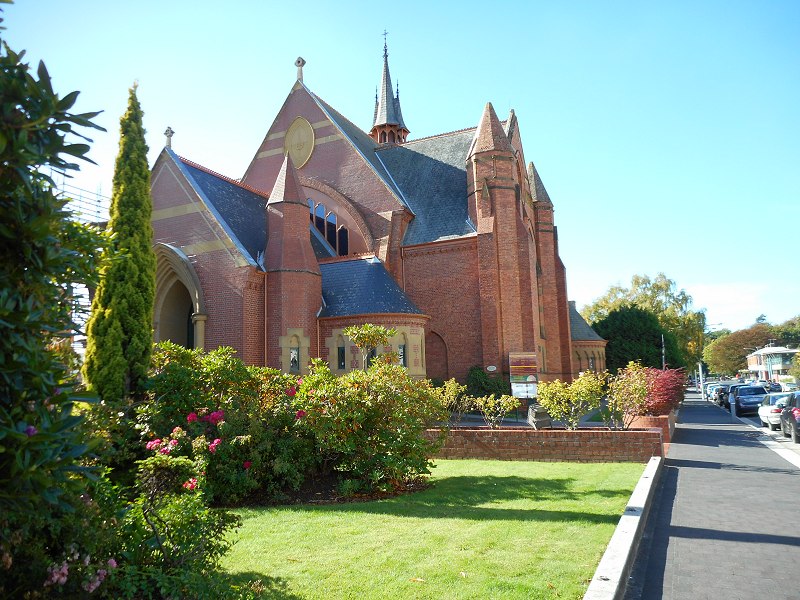
Site of chapel, now occupied by Holy Trinity.
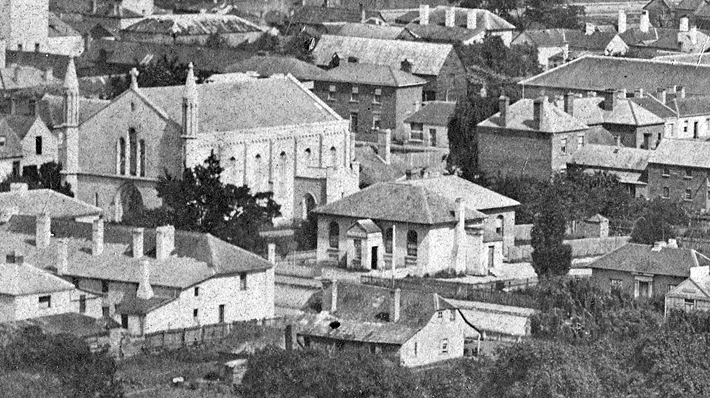
View from Windmill Hill, 1860s. Chapel can be seen in the centre, to the right of the Trinity Church.
(cropped from photo in QVMAG Collection, QMV:1983:P:1196)

Photo from the QVMAG Collection (QVM-1991-P-0107) “View of the Wesleyan Chapel , Launceston, Tasmania, c-1900”
(City School moved to the “premises adjoining Trinity Church” in 1895, so photo is 1895-98
Extracts from two letters on the subject of Rev. John Hutchinson:
11-9-1825 Arrived at George Town and commenced work as a lay preacher in Launceston : was largely responsible for a chapel and parsonage erected in Cameron St
— — 1826 Was withdrawn from Launceston because sufficient money was not available to support the station
(Letter from R.C. Hutchinson to Mr. Holmes, 11 August 1958, QVMAG CHS 82 1/34)
Rev. John Hutchinson was sent to Launceston from Sydney. He sailed in the shop “St Michael”[?[ which arrived in George Town on 31st March 1825. At first he had the load of the court house in which to preach. This was unsatisfactory and the need for better accommodation soon became apparent. Before long, John Hutchinson felt he had sufficient support to collect for the building of a small chapel and subscriptions were invited both in Hobart Town and Launceston. May liberal donations in money and produced were received and a building commenced. Although his return to Sydney was long overuse, John Hutchinson remained in Launceston until relieved by his successor Mr. Esh Lovell, a local preacher who proceeded with work as well as he was able. On the 11 March 1826, John Hutchinson reached Sydney from Launceston after a voyage of eight days.
(Letter from R.C. Hutchinson to Mr. Holmes, 6 November 1959, QVMAG CHS 82 1/34)
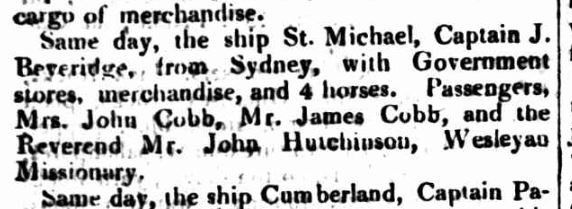
Tasmanian & Port Dalrymple Advertiser, 6 April 1825
It gives us great pleasure to announce, as we trust the “glad tidings” will be received with joy, that by the arrival of the ship St. Michael, we are at length favoured, after many pressing and urgent solicitations, with a Minister of the Gospel — the Reverend John Hutchinson, Wesleyan Missionary. The arrival of this Gentleman amongst us will unquestionably be hailed with no common satisfaction by our aged and respected Pastor; whose arduous and important duties, we conceive, will thereby be considerably diminished. Mr. Hutchinson has been directed by the Parent Committee at home to confine his labours to Port Dalrymple and its vicinity, so that we may calculate upon an extension of his valuable services perhaps for many years.
Tasmanian & Port Dalrymple Advertiser, 6 April 1825
St. John’s Church at Launceston is nearly finished ; and the foundation of the new Wesleyan Chapel was completed last week.
Colonial Times, 16 December 1825
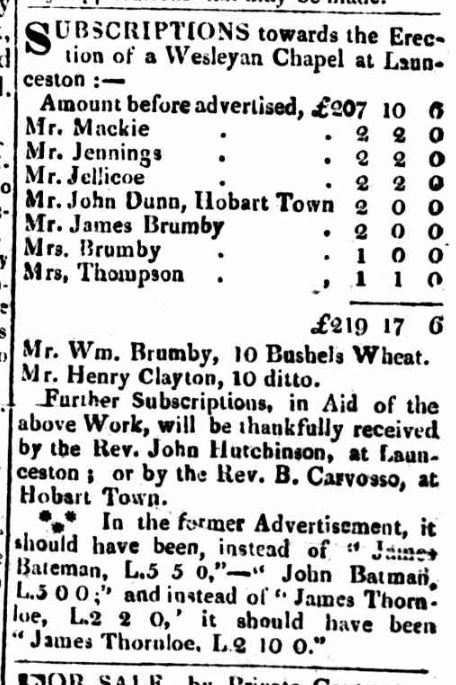
Hobart Town Gazette, 31 December 1825
List of Subscribers, 9 December 1825
Between £200 and £300 have been subscribed for the erection of a Wesleyan Chapel at Launceston.
Hobart Town Gazette, 4 February 1826
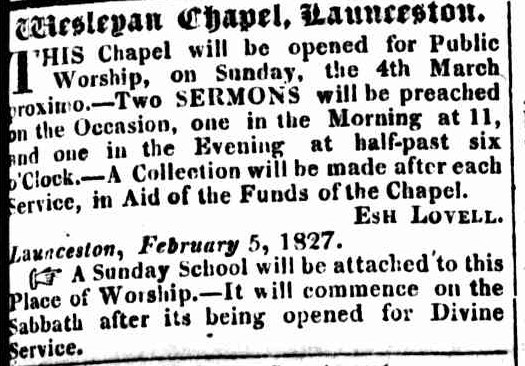
Hobart Town Gazette, 23 February 1827
We are given to understand that an attempt will be made to find what amount will be given amongst the Scotch, and other well-wishers to the Kirk, towards the support of a Clergyman, and should it succeed, which we doubt not, we may shortly expect once again to see two places of worship in this little town. We did, with many others, subscribe, and a Methodist chapel was built, and a Preacher placed here, but for some reasons (unknown) he was withdrawn, and the chapel let to Government for a school ; and the subscribers ought to know why their money is so misemployed, or at least they expect some explanation, or to have the amount of their subscriptions returned.
Launceston Advertiser, 30 March 1829
We announce to the subscribers to the late METHODIST CHAPEL, that some person or persons, are about to sell “IT” the resident Methodist Minister of Hobart Town, appears to sanction this present plan of proceeding, and blame is laid or attempted to be laid, upon a worthy but absent man, for building “IT” as report says without the authority of the “HOME connection.” If he did so act, we are confident he was actuated by the purest of motives, and we are fully aware that had he remained to compleat it, no such debt as the alledged one viz ! £230 would have been at this day, “if ever” upon it- We are of opinion and many join in the same with us, that before, Mr. CARVASSO, or Mr. ANY-BODY, are allowed to sell this ex Chapel, a meeting of the subscribers, ought to be called, and an amicable arrangement made as to the sums advanced, by all parties, be cause, if there is a loss upon the chapel, are the Methodists, at whose desire the money was subscribed are they to come off scott free, and is the whole burden to be borne by those persons who so freely and generously came forward, to erect a place wherein to worship GOD, and that too, at their ( the Methodists own desire) shall they after inducing people so advance, money, land, and labour, shall they add a few pounds, and upon that claim it as their own, and there-upon dispose of this property, We only say” do not this great wrong for evil attend it.”
Launceston Advertiser, 27 April 1829
We have heard that the Wesleyan Chapel at Launceston built by public subscription, is to be sold by private con tract, although it has cost several hundred pounds. We hear upwards of £500 has been offered for it. There is something strange after the piety of the People raising such an edifice that no preacher could be furnished for it. We are rather inclined to think, that Mr. Schofield, who is at present at Macquarie Harbour, could be more serviceable at Launceston than where he is. That Establishment being entirely a Government concern, it ought to be supplied with a Clergyman by the Crown. It is not every day that £500 can be had to expend upon a House of Worship, and we should think if ought not to be lightly thrown away.
Since writing the above, we have read the Launceston Advertiser of Monday last, by which it would appear, that the Rev. Mr. CARVOSSO, or somebody else, on the part of the Methodist body, are about to dispose of the edifice, for a small debt due to the body, without the consent of the subscribers—thereby throwing the whole loss upon the latter. We agree with the writer, that there should be a Meeting of the Subscribers called to settle the affair conscienciously ; and make the loss, if any, fall upon all the parties concerned.
Colonial Times, 1 May 1829
In noticing in our last the want of a Missionary for the Wesleyan Chapel, now built at Launceston, we stated that it was our opinion that the Rev. Mr. SCHOFIELD’s services would be more useful at Launceston, than at the penal Settlement at Macquarie Harbour, with an impression that this settlement should have been supplied by a Clergyman of the Established Church, who are all understood to be paid out of the Civil Establishment. It appears that we were in error, which we now correct. For it seems, that Mr. Schofield is not receiving his salary from the Missionary Society, as we of course imagined, and that the Society at home will only allow one Missionary on their establishment in this Colony, who is to be stationed in Hobart Town. We find that Mr. Schofield was sent out to this Colony expressly for a penal Settlement, at the request of Lieutenant Governor ARTHUR—that his passage was therefore paid by the Government, and that his salary, £100 per annum, is paid out of the Colonial Revenue. This Gentleman is consequently placed upon the Clerical Establishment of the Colony, receiving also the usual allowances of provision, fuel, &c. We are at a loss to account for Missionaries being preferred on these services, unless it be that Lieutenant Governor Arthur considers them more diligent than other Clergymen for such an arduous and unpleasant duty. If so, we approve of the measure ; and we cannot avoid expressing our opinion, that such must tend greatly to improve the condition and mitigate the sufferings of the unfortunate class of men in that wretched place of abode. It seems that Colonel Arthur applied to the Society for two of their Missionaries, the other for the penal Settlement at Maria Island. But as this Gentleman has not yet arrived, and as that useless establishment is said to be about to be evacuated, (which we sincerely hope maybe the case) we trust he will be allowed to proceed to Launceston ; where there is not only a handsome Chapel already erected for his reception, but where we have little doubt he would be liberally supported by the Members of his persuasion. Should the penal Settlement of Maria Island be broken up, we have little hesitation in saying that the Lieutenant Governor would co-operate with the inhabitants, in making a provision for this Gentleman at Launceston ; for which reason we would recommend that the sale of the Chapel be deferred. In the ” Report of the Wesleyan Methodist Missionary Society for 1827,” we find the following paragraph, which corroborates our statement :—
“On the application of the Lieutenant Governor of Van
Diemen’s Land, two Missionaries have been voted by the Committee for two of the Convict Settlements in that country.— One has already sailed to engage in this arduous but useful sphere of labour ; and the Committee with pleasure acknowledge the liberality of Government, in affording its aid to this enterprise. Considering it as a public work, they have appointed an annual allowance from the funds of the Colony to- wards the support of this Mission ; and have furnished also a sum which will, in great part, cover the expence of the voyage.”
We have also to correct another error, we were led into by the Launceston Advertiser, that the Rev. Mr. CARVOSSO, or somebody else, were about to dispose of the Chapel at Launceston, for a debt due to the Society, without the consent of the Subscribers, the edifice having been built entirely by subscription. We have been authorised most positively to state, that neither the Rev. Mr. Carvosso or the Society at home had given any such instructions, and that they had never interfered with this property in any shape whatever. The fact is simply as follows :— The Chapel was built by subscription, collected from the Inhabitants, the Society having advanced no money towards it. Now, that the Society has decided on not sending a Missionary to be stationed there, the house has become useless, and of course reverts back to the Subscribers. It appears that Mr. LOVELL holds a mortgage for about £250 on the premises, which will be sold, for the payment of that claim, and the residue will be undoubtedly divided among the Subscribers, some of whom paid £5 each towards its erection. The School-house or Parsonage, which is also erected on the same allotment as the Chapel, was not built by subscription—it belongs to the Committee.
Colonial Times, 8 May 1828
Although the Colonial Times says that we misled them, respecting Mr. Carvosso and the Methodist Chapel, it now plainly appears that we were right, for we have received an advertisement signed B. Carvosso announcing this very Chapel will be sell except, mark this reader, except that public which so very liberally subscribed 200l. before come forward with 230l more, it appears this debt is owing to one of their own body therefore, he must be saved, from all risk and danger, and although this Chapel, was subscribed for by the inhabitants, at the express solicitation, of two of the Preachers of the Connexion. The public will bear in mind that the Committee the ruling body, never disbursed a penny upon this Chapel. This very member went about soliciting people to advance money to build an house of prayer, many persons gave 5l some 10l and even more than 20l was given by an individual, but all our claims must sink to nothing, before the interests of one of their own body, precious good people these, to their own flock, we simply ask, why has not each individual subscriber, as much right to receive the full amount of his subscription as the money lender ? . we say they have more right because he has been receiving interest, and part of the time a salary while the money of the subscribers laid dead. We rase our voice, and also the voce of a great p[?] of the subscribers, against the sale of the Chapel upon any other terms, than each person sharing in the loss if any. Pray may we be allowed to ask who is this Mr. B Carvosso who takes upon himself to give away to some public charity 200l, of other people’s money? Before you are so generous, be just. Is any of the funds of the connexion so very low? Do they want recruiting, as the expense of the highly ill used inhabitants of this town? We assure them that it will be a very long time before they can again raise such a sum, on any pretence in this place. This will serve as a cautian to more than one generation.
Launceston Advertiser, 25 May 1829
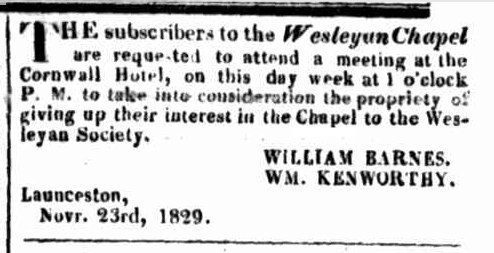
Launceston Advertiser, 30 November 1829
On Monday the 7th instant, a meeting of the Principal subscribers to the Methodist Chapel built in this town, was held at the late Cornwall Hotel, to take into consideration as to the propriety of allowing Mr. B. Carvossa to sell this building, which was erected by public subscription at the instance of the Rev. John Hutchinson, and which Mr. Carvosso unjustly claims as the property of the Methodist Connection; whereas, the money was expressly, to our knowledge, and also by all present, affirmed to have been given to build a Chapel for Launceston, and for no other purpose. It was unanimously resolved, that the Subscribers dissent to the sale of the Chapel, but if the Government wish to purchase it they will consent to convey their right and title on consideration that one full half of the price be paid over to William Barnes and William Ken worthy, Esqs. for the use and benefit of the body of Subscribers.
Launceston Advertiser, 14 December 1829
Dissenters in Launceston.— We cannot help recurring to this subject in our columns of this week because we do think that the Inhabitants of Launceston have not been exactly civilly treat ed. When Mr. Lovell lost his salary as Local Preacher here by the orders of the Conference in England, (after Mr. Hutchinson was removed to the Tonga Isles) in consequence of their being no preacher, the Wesleyan Chapel was sold to the Government for a School-House, after having been previously let for twelve mouths. At this time the Public worship of those persons who do not coincide with the tenets of the Established Church was at an end. Since then the Town has been wholly without any Dissenting Minister of any sect. Now, the said Wesleyan Chapel was built by Public contributions, with the exception of a trifle of cash borrowed from we believe an opulent Banker in Hobart Town). When it was sold the Local Committee gave their consent for the transfer, on the express condition that the subscriptions collected in Launceston, in aid of the building fund, should be returned to them. This has never yet been done, nor has any steps been taken to send us another Minister. This being the case it is a question which the People here have a good right to ask. What has been done with the purchase-money, and where the share which belongs to them (under the terms of the sale) now is ?
Launceston Advertiser, 28 February, 1831
A MEETING of the Scotch inhabitants of Launceston, was held on Saturday the 9th instant, at the school-house, Launceston, for the purpose of taking into consideration the Necessity of Building a PLACE OF WORSHIP for those of the Presbyterian persuasion, and sundry other considerations belonging thereunto, whence the following Resolutions were agreed to:–
1st.-That the Great Body of the Free Inhabitants of Launceston and Neighourhood are Scotch, and have a partiality to the Form of Worship established in Scotland
2nd.-That it is highly desirable that a Presbyterian Kirk be build in Launceston; and also a suitable residence for the Clergyman.
…
12th.— That the Committee do apply to the contributors to the Wesley an Chapel for the money belonging to them now in the Hands of the Colonial Treasurer.
Launceston Advertiser, 25 April 1831
THE WESLEYANS.— We have much pleasure in giving publicity to the following answer, received from the Solicitor-General, to our queries, respecting the money belonging to the Wesleyan subscribers, arising out of the sale of the chapel :
To the Editor of the Launceston Advertiser.
“June 21st, 1831.
“Sir,
“In consequence of a remark in your paper, I write in very great haste, to inform you that the £150 enquired after by some of the late Wesleyan Chapel subscribers, is still in my hands, as stipulated for by the Committee, and ready to be remitted by me, at and when they (the Committee) shall direct. [see letter, copy of which is subjoined]
” Having some 8 or 9 weeks ago, seen an advertisement respecting the then proposed appropriation of this sum, (which was, it seems, then supposed to be in the hands of the Government) I instantly addressed a letter to Messrs. Barnes & Kenworthy, for the purpose of correcting that mistake, and I informed those gentlemen that I should be happy to hand the money over, whenever directed to do so, at the discretion of themselves, and the other members of committee.
” I am of course anxious that no misapprehension should exist on this subject; and I beg of you therefore to let the subscribers understand where their money is, and how it may be obtained.
“I am, Sir,
” Your obedient Servant
” ALFRED STEPHEN.
(COPY)
” Feb. 19, 1830.
” Gentlemen.
“In reference to my last letter on the subject of the Wesleyan Chapel, I have the honor now to inform you that I transmit by this post to Mr. Gleadow the necessary Deeds of Conveyance, which I earnestly request may be executed without delay, as Mr. Carvosso will leave the Colony in the course of ten days or a fortnight.
” I shall be glad for the sake of the Wesleyan Society, to receive a favorable answer as to the smaller sum, which I am disposed to think that the subscribers should consent to accept.
” I pledge myself, however, to retain in my hands the full sum of £150, subject to the decision of the Committee, and to be remitted as, and when, they may direct me; and the deeds executed until I have the money for you. This will I hope induce you, without hesitation, to sign the receipt, as no time is to be lost.
“I have, &c., (
Signed) ” ALFRED STEPHENS”
“W. Barnes, and
W.Kenworthy, Esqs.”
Launceston Advertiser, 27 June 1831

Launceston Advertiser, 14 December 1831
TRINITY CHURCH SCHOOL-ROOM.
ANOTHER HISTORICAL SKETCH.
By E.W.
In the erecting of the new church of the Holy Trinity, the corner stone of which will be laid to-day, its schoolroom, one of the oldest landmarks in Launceston, will be done away with, and many, no doubt, who received there, in days gone by, the first rudiments of their education, will view its destruction with regret.
The early history of this building is very interesting indeed; it did not belong to the Church of England until some years after its erection. The Wesleyans visited Launceston for the first time in 1822, but were very unfavourably impressed with the place, for the Rev. W. Horton, writing to Sydney for help, remarked, “The wickedness of the people of Launceston exceeds all description.” They did not remain then, but returned in 1826, and built a small chapel and parsonage (the present school and verger’s cottage), and the Rev. J. Hutchinson was placed in charge.
In 1828, however, or two years after, the Wesleyan Mission Society withdrew its aid, and the minister was withdrawn; the buildings were then sold, the Government becoming the, purchasers, and John Pascoe Fawkner, “the father of the colony of Victoria,” who at that time kept the Cornwall Hotel (or Cornwall House, as it was then called) opposite, was appointed trustee, and held the proceeds on behalf of those subscribers who contributed to their erection.
I will now ask my readers to excuse a slight digression, as it will no doubt be interesting to many of them to know what became of the proceeds of this sale. The Rev. J. Anderson, a Presbyterian clergyman, was the next to settle in Launceston after the second departure of the Wesleyans, and the first thought of our Scotch friends was to build themselves a kirk; many of them, no doubt, had been, original subscribers to the little Wesleyan chapel, but whether they had or not, they at once called a meeting of those interested in the money held by Fawkner, and appropriated it towards the establishment of a Presbyterian; Church, and thus was built the first Scotch. national church in Launceston. Most of my readers will remember the building, situated in Charles-street, near the old market, and now forming part of Mr. James Walden’s store. A year or so ago, this building with the land attached to, it was sold to Mr. Walden, and the proceeds have assisted our Presbyterian friends to erect for their minister a comfortable manse on the Elphin road.
I should have hesitated before writing the above had not accidentally come across the following in the “Launceston Advertiser,” of December 28, 1 1831:–
PRESBYTEREAN KIRK, LAUNCESTON.
The subscribers to the Wesleyan Chapel, Launceston, are respectfully Informed that their committee have paid into my hands £150 sterling (being the sum originally deposited with Mr. Stephens), to assist in erecting a Presbyterian Kirk in Launceston. Those subscribers who do not approve of this appropriation may have a due proportion of the £150 returned to them by giving me notice at any time before the 31st day of December 1 next. If no claim be made before that time, it will be considered that this disposal of the money is unanimously approved, and the whole will be used accordingly.
THOMAS SCOTT, Treasurer.
Presbyterian Kirk, Launceston, November 12th, 1831.
I must now return to the buildings, the subject of this sketch. The chapel was converted into a Government school, with Mr. John Headlam as first master, and the parsonage into a commissariat store. Mr. John Headlam left the public service in 1831, and his family have been well and favourably known on the Macquarie ever since. He was succeeded at the public school by Mr. and Mrs. Peter Jacob, who remained there till the building and ground were granted by Government to Trinity Church, they then removed to Longford, and will be remembered by many in connection with the post office and windmill on that township. Mr. Peter Jacob was also one of the first Wesleyan local preachers.
It was while Mr. and Mrs. Jacob had charge of the public school that the building was first used as a Sunday school, this was in 1832, Mr. Henry Dowling being first superintendent, and Mrs. Theodore Bryant Bartley first lady teacher. The “Launceston Advertiser” of April 20, 1833, gives the following account of our first Sunday school anniversary; it is as follows:–“The first anniversary meeting of the friends and subscribers of the Launceston Sunday school was held .in the Court House, Lieutenant Friend, R.N., in the chair. The report and work of the committee was read by the secretary, Mr. Henry Priaulx. It was resolved that the children should meet at the Government schoolhouse (opposite the Cornwall Hotel). They were addressed by the Rev. Dr. Browne, and the Rev. J. Anderson (the newly arrived Presbyterian minister). Afterwards the children were entertained by a profusion of roast and boiled meat, and plum pudding in the long room of Mr. Fawkner’s Cornwall Hotel.
Mr. Henry Dowling remained superintendent for four years, when Mr. Peter Jacob, who had previously been secretary, was appointed, and he again was followed by Mr. William Henty. There are many now in our midst who remember the Sunday march, two and two, from the school to St. John’s Church. Trinity Church was opened for Divine service in December, 1842, and soon after there came the break up of the Sunday-school Society. In the following year St. John’s school-room was built, and since then each church has had its own Sunday school. It is worthy of remark, that up to this time all denominations took part in the work of the school, and worked amicably together for the common good; and that even after the Wesleyans had started a school of their own in 1835, many of their leading members continued to teach in the old school, until the division in 1843, when they were the recipients of hearty votes of thanks.
The buildings, that is the school and verger’s cottage, have belonged to Trinity Church since 1842. The wardens of the church have, when they could, let the school building to private individuals. Amongst those who have at different times rented it as a private school may be mentioned Mr. Abraham Barrett, Mr. Thomas Hogg, W. Ockleton, and now Mr. Cunningham.
Trinity school-room was also the birthplace of the Launceston Mechanics’ Institute. In the address of the chairman (Mr. H. Button), delivered on March 8, 1892, on the occasions of the jubilee of the institution, it is stated that the first committee, having got together 80 volumes, obtained the use of the public school-room in Cameron-street for the purpose of a library, and a small recess was built on its eastern side to form the depository for the books. The recess remains to the present day. The first general meeting of subscribers was held in the schoolroom, Wm. Henty occupying the chair, when the rules and orders for the government of the institution were read by Mr. T. J. Connor, and adopted. The old school-room has, of course, been used repeatedly for entertainments of all kinds in connection, with the church, and has been added to and improved on various occasions. It has served its purpose well and faithfully for many years; and there will be a feeling of sadness with many when its walls are being demolished.
Launceston Examiner, 9 February 1898
Australia’s Forgotten First Revival in Launceston in 1832 – Malcolm Nicholson
November 29, 2021 at 11:55pm[…] Holy Trinity Church (Anglican) was built next to the old Methodist chapel. The photo below from Cemeteries & Churches & Things was taken from Windmill Hill in the 1860s. It shows the old Holy Trinity Church on the corner of […]